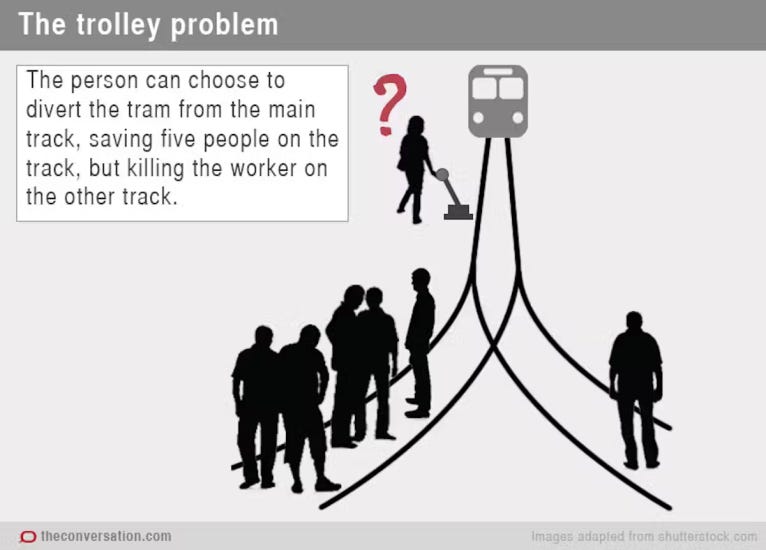Numbers versus morals? Numbers and morals? Part I: Oct 8
Should a different decision have been made regarding the ground invasion into Gaza?
On 16 Jan, the Jewish Press published an article entitled: “Our Ministers are Sending 380 Israelis to their Deaths.” How does the author get to that figure? And how is this related to the moral issues with which Israel’s leadership is confronted regarding the hostages still in Gaza?
When I began writing this article, I intended to concern myself only with the hostage “deal” but as I got deeper into it, I realized that I wanted to contend with the decision to conduct a ground invasion as well. Since dealing with both in one article would make too long an essay, I decided to do it in two parts, with part one concerning the ground invasion. But I will set the stage for both parts by an introduction that considers the hostage “deal.”
The calculations
Addressing the cabinet before the vote on the hostage&(temporary)ceasefire “deal,” author Susie Dym told ministers that:
Anyone who votes "in favor" and hopes to save 33 – know that your raised hand is going to kill an estimated 380 Israeli men, elders, women and children.
She reaches this figure by taking into account terrorists released in the 1985 Jibril deal, the 1990s Oslo period, the 2005 Tannenbaum deal, and the 2011 Shalit deal and the number of Israelis killed by them:
About 12,000 terrorists released by previous governments, murdered about 2,750 Israelis.
Using this ratio, "your" 1,650 terrorists are expected to murder about 380 Israelis.
(Of course, this does not include those Israelis who were “merely” maimed and require rehabilitation both physically and psychologically, some for many years.)
I was never good at arithmetic but, using Dym’s figures, it looks to me like we can say that each murdered Israeli is equivalent to almost 23 terrorists. Or: for each 23 terrorists we release in such exchanges, one Israeli will be murdered. That is a wild generalization as some kill far more and others either do not re-engage in terrorism or are unsuccessful in their murder attempts.
Perhaps a more salient numbers comparison is the 33 released hostages (supposedly only about 23 are still alive) and the 380 Dym predicts will be killed by the terrorists set free for them. That might be like saying that for every released hostage, ten Israelis will die in future attacks.
This reminds me of a famous trolley car thought experiment that bridges the fields of psychology and ethics. A good summary of this is in the article entitled “The trolley dilemma: Would you kill one person to save five?” and it is illustrated by this image in that article:
A more in-depth treatment of the various permutations of this dilemma, that make it relevant for our hostage case (and perhaps even our initial response to Oct 7th had anyone been willing to consider it) can be found in Judith Jarvis Thomson's chapter in a book entitled Ethical Theory. I recommend you read it — it is only eight pages long but requires concentration and is partly in response to the chapter preceding it (just scroll back to it).
Essentially, the author is examining the question of whether it is okay to kill one person to save five and if there is a difference between killing someone or just letting them die. Let me put this in terms related to the hostage dilemma and I will start with something that perhaps could have been asked on Oct 8th if anyone was willing to consider it.
Oct 8th question:
The government engaged in air attacks but these were limited and the decision was made to prepare for a later ground invasion in which great care would be required to avoid killing hostages accidentally while taking out Hamas militia and infrastructure. There was also the hope that a ground invasion would allow the IDF to rescue hostages and retrieve bodies Hamas took into Gaza.
Could the government have anticipated the potential cost in soldiers’ lives and the damage and injuries from nonstop missile launches from Gaza toward Israel? If so, perhaps out leaders could have decided the cost was too great and Hamas had to be dealt with immediately. That would have meant, essentially, sacrificing the hostages’ lives by engaging in more massive air attacks over Gaza.
Would it have been moral to do that?
Would it have been moral to sacrifice 251 lives to save the 800 plus soldiers’ lives (the exact number was unknown back then but we knew many would be killed in battle)?
It is as if we put the hostages on one track in the image above and the soldiers on the other. The train is going to kill those on one side or the other; it is unavoidable. Our leaders decided that it was right to risk soldiers’ lives to try to save the lives of the hostages.
Thomson suggests that we need to consider the question of who had a claim that their lives needed to be protected/who had a right to protection. And whose claim or right outweighs the other.
It is obvious that the civilians among the 251 hostages did nothing to cause their abduction and, as members of a society that vows to protect them, they have the expectation that society will rescue them. It is also true that the job of a soldier is to fight and every combat soldier is well aware of the risks involved. Therefore, the claims and rights of the civilian hostages override those of the soldiers. (I know there is a “but” here, but let us come to that in Part II of this article.)
And, in fact, we heard from the soldiers in the field that they were fully in synch with their goals and their determination to fight at great risk to themselves did not waver. They had the support of their families as well. Everyone knew that it would have been easier to have achieved the goal of destroying Hamas had the IDF attacked from the air but the risk was accepted for the goal of trying to bring hostages out of the tunnels and homes in which they were being held.
Until…..until we get to the so-called hostage&(temporary)ceasefire “deal” and some are starting to ask if it was the right decision after all.
(to be continued in Part II)
Because Israel is not supported on the Substack payment platform, I have set up an alternative for those who want to support my work.
You can make one-time or repeated donations in your own currency using Paypal (Buy me a Coffee, above) or the Ko-fi payment platform here. Israelis can send me a private message for another option.
Articles will always be free for all subscribers but a one-time or repeated donation is a way to help me sustain myself while doing all the work involved in putting these articles together and would be greatly appreciated.
Thank-you to all those who have supported my work by subscribing and/or by donating coffees.




God help us that such numbers need be crunched. :( Praying that “A bird in the hand…” proves the better bet.
Hurry with Part 2!